► Ferrari vs McLaren
► F8 and 720S drop tops tested
► Which comes out on top?
Ferrari and McLaren’s rival convertibles target each other more closely than ever. The spec sheets won’t tell you which one’s best – but we can. Read on for our twin test.
Ferrari F8 Spider: personality test
If it were a Tinder date…
Straight down to it, insatiable, adventurous, whether it’s first thing Monday or closing time on Thirsty Thursday.
Ooh, doesn’t he look like his dad?
And his granddad – F8 is a reworked 488, itself a reworked 458. All great cars, none broken, just lovingly tickled.
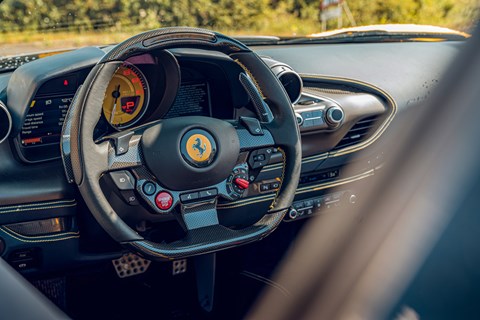
What’ll it do, mister?
Oh gawd, not this again. Everyone asks, whether you’re at the petrol station or pound shop. Plod even followed us home to talk.
Folding roofs at dawn?
F8 might ‘accidentally’ over-sleep this one. Its 488-based hydraulic roof folds up or down in 14sec and up to 28mph. Which is impressive, but second best.
McLaren 720S Spider: personality
If it were a Tinder date…
Takes a little small talk, but the tease makes the unbelievable filth that follows all the more… oh God!
Ooh, doesn’t he look like his dad?
Nah. There’s a McLaren family look, and the mechanical kit evolves from 650S, but 720S is an all-new design.
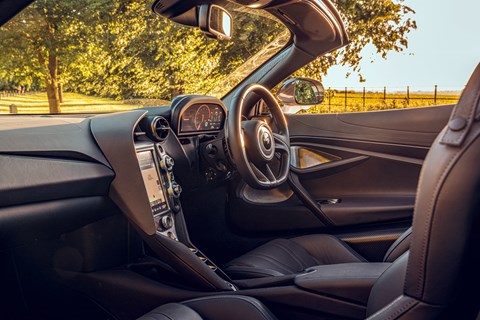
What’ll it do, mister?
0-62mph in 2.9, 212mph flat out, 710bhp … all as per Fezza. Sometimes you’ll find random people who want to know.
Folding roofs at dawn?
New folding roof and ‘leccy mech does the biz in just 11sec and at 31mph – own a McLaren forever and you’d bank two weeks’ life vs the Ferrari.
Heat-seeking missiles: the test
Supercar tests are always memorable, but a few seconds of this Ferrari F8 Spider and McLaren 720S Spider showdown stick so vividly in my memory it’s like rewinding a video. Editor Ben Miller’s ahead in the McLaren, roofs are lowered to let warm evening air swirl in and, after a long run uphill, Ben brakes for a left-hand hairpin. The 720’s twin eyebrow-like rear lights glow red and its active rear spoiler rises gracefully like a Samurai war fan. There’s a rifle-crack of a downshift and the McLaren’s V8 briefly growls over the Ferrari’s, the Italian car still running in a higher gear.
I brake and pop in a downshift, momentarily raising the Ferrari V8’s volume above that of the McLaren. We rush around the corner. Climbing back on the power, 710bhp has the Ferrari’s Michelins chewing on the grainy surface while the McLaren’s rear Pirelli P-Zero Corsas are wreathed in smoke. There’s raucous noise, heaving acceleration and the smell of toasted rubber rushing into the Ferrari’s cockpit. Few driving moments have engaged my senses so completely.
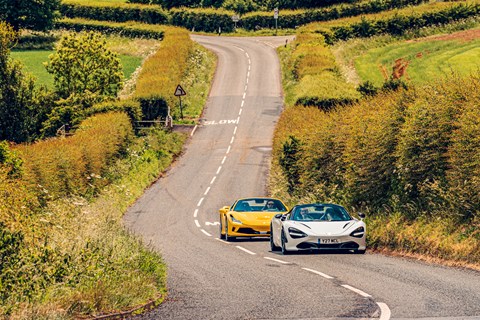
If this test is unforgettable, I’m struggling to remember comparing two machines quite so evenly matched. Both are mid-engined supercars with folding hardtops that open in a little over 10 seconds. Both rocket from standstill to 124mph in around eight seconds, courtesy of twin-turbocharged V8s with flat-plane cranks and dual-clutch gearboxes. And both sail past £220k before you even get into the lavish options that push these test cars towards £300k. Their 710bhp and 568lb ft outputs, 2.9sec 0-62mph times and 212mph top speeds are interchangeable.
The Ferrari F8 Spider is the convertible version of the F8 Tributo coupe we tested last year, the marginally newer machine here and Ferrari’s ‘entry-level’ mid-engined V8 (the front-engined Portofino is ‘cheaper’). The F8 splits the difference between the 488 Spider (to which it’s closely related, and which it replaces) and the more aggressive, track-focused 488 Pista, whose performance it matches.
McLaren’s 720S Spider (a Super Series model) sits a rung up from its ‘entry-level’ Sports Series 570S. While still related to the 650S it replaces (and the 12C of 2011 before that), there’s more of a step in terms of design and engineering than with the Ferrari – this in turn has helped McLaren close the gap compared with almost a decade ago, when Ferrari’s 458 soundly whipped McLaren’s 12C. It’s why this fight is going down to the wire.
I jump in the Ferrari first, dropping into a firm seat with a low, well-sorted sports driving position and good visibility; it’s a friendly, usable environment, but one still heady with drama. The F8 updates the 488’s interior, but you could never mistake it for anywhere else given there’s a central tacho with pod-like digital screens either side, a spine of carbon that rises from the floor, studded with transmission controls, and an oddly shaped steering wheel covered in buttons to mimic Leclerc’s.
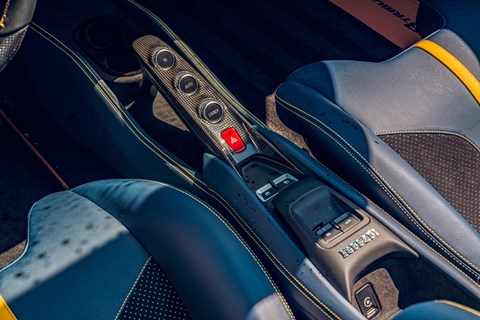
Ben comments that the Ferrari cockpit has dated now we’ve seen the upcoming Roma interior. The tacky silver script, a tiny infotainment screen, the anthracite finish on the air vents and the climate control buttons reinforce his point. But what’s here is very nicely finished, with a flashy kind of excitement, and still no one lets you shift through driving modes as effectively as Ferrari’s steering-wheel-mounted manettino – go from cautious Wet mode to balls-out ESC Off in a second without taking your hands from steering wheel or your eyes from road. You need the owner’s manual in the McLaren, with its toggles and buttons and mode-based caveats (no ESC off in Comfort handling, for instance).
The Ferrari’s roots date to the 458, which evolved to become the 488 Spider in 2015 (20 per cent stiffer structure, new twin-turbo V8, a roof that could be lowered on the move), so when you press a button to drop the roof, it’s essentially the same folding hardtop as the 458. This two-piece lid twirls away beneath a tonneau cover like a shoal of fish disappearing in a whale’s mouth, the whole mechanical ballet requiring just 14 seconds and possible at up to 28mph.
Like the McLaren, you can also drop the vertical pane of glass behind you to let air flow in without the bluster of dropped windows (handy at high speeds, also in the wet) and it means the F8 has better rear visibility than the Tributo’s slatted Lexan rear screen. There’s nothing new here, but neither does there need to be.
But the real F8 Spider USP is its engine, drafted from the track-focused 488 Pista. It’s similar to its predecessor’s 3902cc twin-turbocharged V8, but it wouldn’t take scrutineers long to find the naughtier bits. In fact, Ferrari says 50 per cent of parts are fresh, including titanium conrods, crankshaft and flywheel, Inconel manifolds derived from the 488 Challenge racer, plus the air intakes have been moved from the flanks to either side of the blown rear spoiler for better airflow to the inlet plenums.
All of which makes an engine that was already a benchmark for power and response perkier, more powerful and 18kg lighter. The headline is an extra 49bhp in a car 20kg lighter than before, a significant increase even if the roof and some under-body bracing to reinforce the structure add 70kg compared with the Tributo coupe.
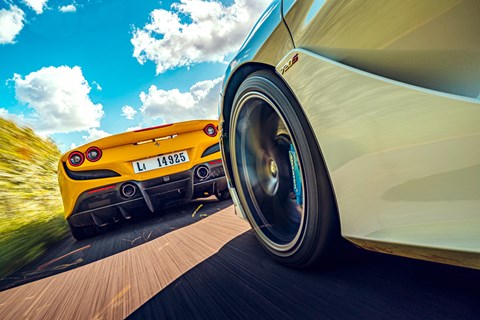
Astonishing performance is relatively easy – it’s how Ferrari serves it up that’s the big win, blending the instant pick-up, linearity and high revs of naturally-aspirated engines with the midrange muscle and additional peak power of a turbo. Performance is everywhere. Dual-clutch gearshifts gel so perfectly with this punchy character that it’s hard to imagine a three-pedal alternative: the instant blams and pops augment the engine’s precision
delivery and excitement, while seamless shifts at gentler speeds complement the Spider’s any-mood duality.
Yet for all the technical achievements, the V10 Lamborghini Huracan is more responsive still, less potent but still excessively rapid, and with a serrated yowl at high revs that neither turbocharged McLaren nor Ferrari can match. The Ferrari engine gains a gasoline particulate filter for the F8, so more of its emotional pull has been trapped like gold in a sieve before it flows further downstream: idle has a charmless tick and higher revs trade wavering treble for grittier bass. And so Ferrari moves towards gruff McLaren territory while the McLaren in turn has improved. Once again, that playing field is levelled.
The chassis and carbon-ceramic brakes carry over from the 488, but again there’s very little to fix here. The structure feels solid (no shakes through steering column or rear-view mirror) and it rides well, particularly with the softer Bumpy Road setting engaged, but there’s a little more wheel patter than the Tributo, especially roof-open.
Nit-picking aside, the Ferrari is a sensational drive, with steering, braking and handling to match the engine’s tight, responsive feel. Above all it’s how calm the Ferrari feels when you coax it through corners; very little roll, no sense of distortion or stress as g-forces increase, just consistency and the lightweight purity and tip-toe agility you get with a mid-engined layout. It hooks right into corners like an aerobatic plane, the rear following obediently, and you sense weight shifting and loading the outside rear wheel. For a split second there’s a choice: keep the throttle steady and maintain that delicious balance, or give it a quick lift and a squirt to playfully and easily adjust the angle of the rear end.
It’s a ball even in Wet mode but in Race the F8 palpably tightens; any residual fuzz is entirely dialled out. This is the sweet spot, with everything you turn and squeeze and stomp loaded with the most delicious tension, where the McLaren, particularly in its pedals, feels less precise. Race is also the threshold at which Ferrari’s Dynamic Enhancer Plus system kicks in: complicated software that allows enough slack to throttle-steer the rear but enough supervision to limit calls to the insurance hotline (I did not call it crash-proof).
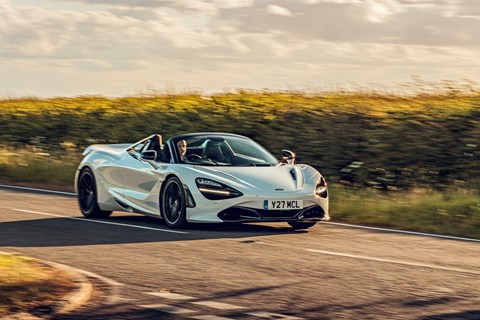
Rainfall from a flash downpour is quickly baked off by the hot summer tarmac and a return of the sun, and steam’s rising from the surface as I head out for my first drive in the McLaren. Like the Ferrari, the 720S Spider still owes a debt to its predecessors, namely the 12C and more recent 650S: the carbonfibre tub around which all McLarens are constructed is related, as are the twin-turbo V8, seven-speed dual-clutch transmission and the interconnected dampers that remove the need for fixed anti-roll bars.
But this is a more complete reinvention: the exterior and interior designs are new, and the carbon tub now extends up into the A-pillars and the rollover protection structure behind the seats. The engine grows from 3.8 to 4.0 litres, the suspension uprights and double wishbones are re-engineered to be 16kg lighter, and there’s a different control strategy for the dampers (a predictive set-up developed with help from Cambridge boffins, no less).
The entire folding hardtop is also new, from outer shell to inner electric mechanism. The one-piece carbonfibre roof looks neater than the Ferrari’s and sits lower than a 650S’s roof when stowed, improving rear visibility. It also lowers or raises in 11 seconds, three seconds faster than the Ferrari, and will operate at 31mph, 3mph faster – two small differences that make dropping the McLaren’s roof while trundling with 30mph traffic easier.
Like F1 cars, it’s only up close that you truly appreciate how carefully the McLaren’s body is sculpted to manage airflow, not to mention how innovative McLaren design boss Rob Melville has been in packaging it all in such a low, tight, dramatic design: particularly the eye-socket headlights that flow cooling air to the low-temperature radiators, and the body sides that appear clean save for muscle sinew from a distance, but conceal vast channels to flow air to the high-temperature radiators. At the rear, engineering is teased through the diffuser and P1-style mesh, like flashes of a cyborg’s metal carcass beneath a layer of torn flesh – the transmission casing, braided oil lines, suspension arms and the exhaust system – although there’s no flash of the engine, just like the Ferrari.
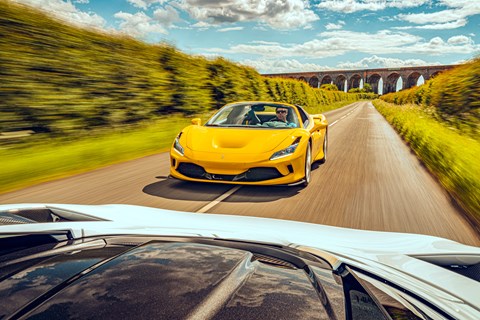
The McLaren’s Monocage II does evolve to accommodate the folding roof (officially it’s II-S), but the strength of the McLaren tub means it doesn’t require structural reinforcements, so weight increases only 49kg versus the 720S Coupe, and leaves the McLaren’s 1332kg dry weight some 68kg lighter than the Ferrari’s.
The McLaren is more exotic to climb aboard, with dihedral doors that swing up and forward to reveal a thick carpeted chunk of carbonfibre chassis. Climbing in and out is a little harder, and the taper of the tub pushes the pedals inboard, so it feels natural to left-foot brake, but it’s no stretch to climb in if you’re reasonably limber, and these seats offer slightly plusher comfort, if still with a welcome hug of lateral support.
Inside, the McLaren feels more focused than the F8. There isn’t a single button on the wheel, though there’s still theatre, including the curves that flow through the door casings, the twist of carbonfibre rising like vines up the A-pillars, and the dash that rotates to a thin strip in Track mode.
Visibility is fantastic, the airiness of the architecture enhanced by our car’s optional electrochromic glass roof, which lightens or darkens at the touch of a button. A portrait info screen is more modern than the Ferrari’s. Equipped with its optional sports exhaust, the McLaren rouses with a deep growl that’s more tractor than tuneful, but it sounds serious and certainly gets the butterflies swirling. Head out onto the road and it rides flat and firm but also with the impressive compliance gifted by interconnected dampers and the lack of anti-roll bars – even the third and most aggressive Track setting has compliance enough for the road, though it’s pretty hardcore and mostly Comfort is best. There’s a gritty feeling to the McLaren dynamics, with more weight at the top of the steering than the Ferrari, and a more granular feel through the steering rim. It turns hungrily and has a similarly low, hunkered feel.
Up front, the McLaren runs optional P-Zero Corsa tyres of a smaller 19-inch diameter than the Ferrari’s 20s (though both have a 245/35 section and sidewall) so perhaps the grippier, smaller front rubber lends extra texture as well as more nuanced steering behaviour than the Ferrari (which optionally wear grippier Cup 2 tyres). Both have 305/30 ZR20 rear tyres.
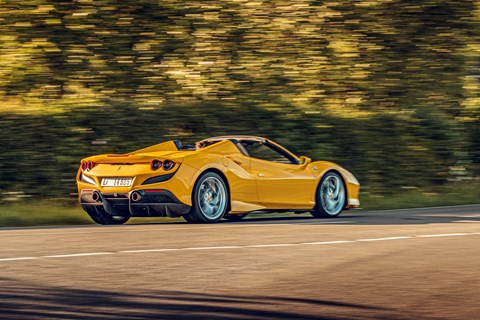
Drive the McLaren ambitiously at a slower corner on the brakes and its front end sticks hard, but in quicker corners it pushes more than the pointier F8. This isn’t killjoy plough-on understeer, but a brief, subtle phase of the cornering process. With a lift of throttle, the balance shifts to bring the tail round just a fraction before you can crush the throttle again. If this is key to unlocking the McLaren’s beguiling dynamics when driven harder, it’s also a more intuitive rhythm than it sounds because the McLaren so clearly asks you to do it.
McLaren upsized its ubiquitous twin-turbo V8 from 3.8 litres to 4.0 for the 720S, and upgraded 41 per cent of parts (lighter pistons, conrods, crank, new turbochargers with faster-spooling turbos) so it is more responsive as well as 69bhp more powerful. But its underlying character hasn’t altered greatly: there is still turbo lag to chew through until north of 3000rpm, and the powerband is narrower and less linear than the Ferrari’s – the McLaren’s 710bhp peak is delivered 500rpm lower at 7500rpm, and the full 568lb ft torque doesn’t arrive until 5500rpm to the Ferrari’s 3250rpm. The throttle is less sensitive, the delivery less linear.
Likewise, the dual-clutch gearbox isn’t quite as snappy, more so on downshifts, but like much of the tit-for-tat between these two, it’s all relative – the snap of a full-throttle upshift in the Track powertrain setting never feels lacking (those rifle-crack downshifts are a bit shocking, though), and the kick of boost and the final 1000rpm when speed and noise coalesce is so ferocious that it consumes your attention completely.
The less responsive powertrain does have a bearing on the McLaren’s dynamic qualities, but it’s not all negative. In the same corners that you can park the Ferrari on the apex in second gear and then slide all the way out of, the McLaren’s traction isn’t troubled at all because the engine’s still napping. It’s not like the first F1 turbo days when drivers talked of pushing the throttle two seconds before it was required, but you do accelerate hard and early and make big, definitive inputs in the McLaren where the Ferrari encourages a finger-tippy approach. You have to monster it, and I like that.
The spit of torque when the McLaren boosts initially invites a kind of oven-gloves caution to inputs, and there isn’t the same precision sense of its diff locking (because it doesn’t have one) and the throttle crackling with energy as the Ferrari, which gives you such fine control over the F8’s cornering and oversteer behaviour. But with everything switched off the McLaren actually feels more progressive, riding out slides with its fat rear rubber hunched down on the tarmac – fast things seem to happen a little slower, and you’ve also got Variable Drift Control to help out (again, still crashes, but less likely). The F8 is highly controllable and engagingly playful, but it is noticeably more flighty and enthusiastically Italian than the stoic Brit. The detail you feel in the McLaren also makes the Ferrari feel a little digitally enhanced in comparison.
Ferrari F8 Spider vs 720S Spider: verdict
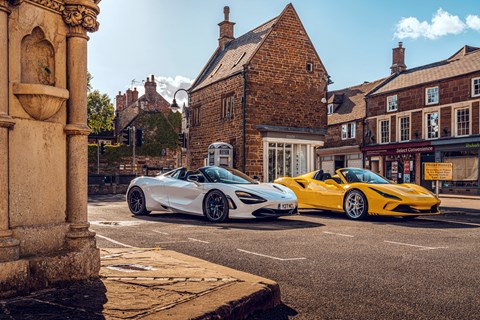
For all their startling similarities on paper, these two supercars could hardly feel more different to drive. There are clear technical areas where the Ferrari beats the McLaren, most notably the tightly coiled muscle of its powertrain, and as an ownership proposition the Ferrari is probably sounder, with seven years’ servicing thrown in and residuals that are a safer bet partly due to the Prancing Horse’s extra prestige. It also drives with such excitement that it’s probably the closest most of us will come to spontaneous combustion (and started every time, where the McLaren failed to detect its key for 10 minutes, a known glitch).
These are not trivial factors and should weigh heavily on any purchase, but given the option it’s the McLaren with its grit and authenticity that I find the more engaging machine to drive. It’s a lighter car, and has the faster roof, and even its less linear power delivery has a likeable kick of attitude.
Less than a decade ago Woking routinely lost these head-to-heads with its Italian rival. It’s come a heck of a long way since – and on this occasion it wins.
McLaren 720S Spider
★★★★★
Ferrari F8 Spider
★★★★★
Check out more CAR comparison tests here